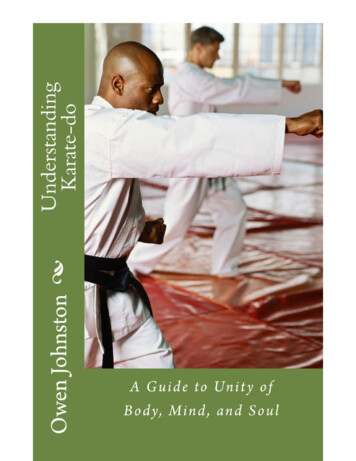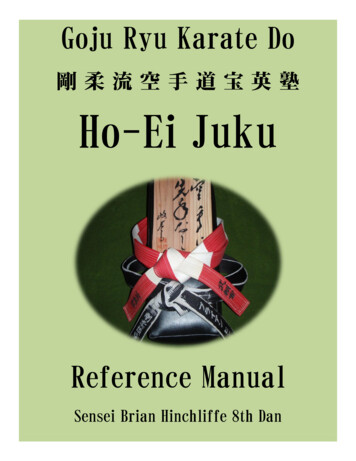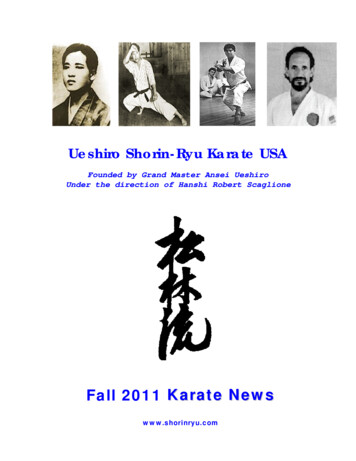
Transcription
CHITO-RYU KARATE-DO NEWSLETTERWINTER 2006Chito-ryu Karate-DoPublished in the Interest of Chito-ryu Karate by the U.S. HombuCelebrating O-Sensei Tsuyoshi ChitoseStates in 1973 and 1982. On June 6th, 1984 an historicalera in the history of karate came to an end. It isimpossible for us to understand everything about OSensei, but we can refer to this song O-Sensei wrotemany years ago:STUDY HARDYOUNG MENUS Chito-kai clinic NorthernKentucky University 1973October is the month we celebrate the birthday of ourfounder Tsuyoshi Chitose. The United States Chito-kaicommemorates the event each year by holding aSeminar and National Banquet. O-Sensei was bornOctober 18th 1898 and passed away June 5th 1984. All thatknew him have many fond memories; O-Sensei was notonly a karate teacher he was a husband and father. Hestarted his karate training at the age of seven under theOkinawan master Aragaki Seisho. As he grew older hetraveled the Okinawan islands in search of moreknowledge and trained under several noted todemasters. Dr. Chitose received his medical degree fromTokyo University and continued to teach Karate onmainland Japan. He had a vision that karate was not onlyuseful for self defense but also as moral and physicaleducation. Karate could be used not only to defeatothers but also to help others. In 1950 O-Sensei retiredfrom medicine to teach Karate full time. One of hismost famous students was Masami Tsuruoka, Father ofCanadian karate. Tsuruoka Sensei was awarded his blackbelt by O-Sensei in 1949 and was recently promoted to10th dan by the National Karate Association of Canada.In the early 1950’s our founder William J. Dometrichwas fortunate to meet O-Sensei when he was stationedin Bepu, Japan with the US Army. After muchpersistence he was accepted as a student. In 1967 OSensei traveled to North American and visited theUnited States Headquarters. He would visit the UnitedStudy hard, young menThe sky is a huge domeYoung men as strong assteal,With shining hopesOur great Chito-RyuBased on PhysiologyTo defend the weakTo Create world peaceWith 7 parts strength as abase,Training our bodies wepolish up our ski%sA% together, let us extendA% –powerful karatethroughout the worldOur true Chito-ryuO-Sensei June 11, 1922Miyako, OkinawaThrough the teachings of Sensei who pray for peaceWe sha% attain the spirit of enduranceThis is true Karate.Arrogance and weakness are obstacles to training,We sha% continue our tough trainingThe Chito-ryu.Hanshi and I are blessed with a tape of O-Sensei singingthis song; we will never forget those memories. Throughconstant practice you can seek self- perfection, humilityand self-understanding. In the United States Chito-kaiwe do not have Masters, however now that O-SenseiTsuyoshi Chitose is gone, he is a true Master.UNITED STATES CHITO-RYU KARATE-DO FEDERATIONBy: Barbara E. Dometrich, KyoshiPAGE 1
CHITO-RYU KARATE-DO NEWSLETTEREDITORIALWINTER 2006THE KARATE-DO STAFF“THE DISCIPLINED SAMURAI”A few centuries ago a samurai traveled to a small fishing village on thesouthern tip of the southernmost main island of Japan, the island of Kyushu.This village was made up of fisherman and a few farmers who farmed the flatland around the village.Barbara DometrichOkusan@eos.netEditor-in-ChiefHombu DojoCovington, KYIt was early morning and the sun had just risen on the village when thesamurai Hiroshi Yamada strolled into the village. He was an imposing sight,armor, three swords and the walk of a man bearing a mission.Cyna Khalily, MDHe walked up to a fisherman, who immediately bowed to him. “May I helpyou?” the little fisherman asked, trembling. “Kazumi Tabata wa doko desuka?” (Where is Kazumi Tabata?) The samurai asked politely. The fishermanpointed slowly to a man not twenty feet away who was repairing a fishing net.The samurai asked the fisherman his name. “Who wants to know?” thefisherman replied loudly. “I was sent here by the Shogun to execute you fornot paying your taxes” the samurai replied.“I have no intention of paying taxes” the fisherman said loudly. The fishermanthen spat into the face of the samurai and said “I am not afraid of you.”Cyna.Khalily@chito-ryu.comAssistant EditorYoseikan Taka no koLouisville, KYMina Ludwig, EsqMina.Ludwig@chito-ryu.comStaff writerYoseikan IIThe samurai looked shocked, stepped back, bowed, turned and left the village.After he was gone, the other fisherman congratulated Tabata-san and he wasthe talk of the village.Three weeks later the samurai entered the village in the morning and walkedup to Tabata-san’s boat. Tabata-san upon seeing him bowed. The samurai’ssword flashed, Tabata’s head flew from his body and landed on the beach.The samurai quietly turned to leave. The old fisherman bowed and asked“Wasn’t it you who was here three weeks ago?” “Yes”, the samurai replied“That day he made me angry. I was taught by my teacher to never draw mysword in anger. Today I am not angry.” Thesamurai, a very slight smile on his face,turned and left the village.Sensei Patrick McCarthy told me this story afew years ago. It is the essence of budotraining. Take no action out of anger or fear.Train, develop your skill, insight and yourability to keep your head when other menloose theirs. Such is a mark of a rankingYudansha.Cincinnati, OHMichael Collingmcolling@ns.sympatico.caStaff writerMarion Bridge YoseikanNova Scotia CanadaCONTRIBUTORSHanshi William J. DometrichTony DiTerlizziGordon LevinDon SchmidtWillie Elliot, DMinRichard RilkeWilliam J. Dometrich, HanshiFounder and Chief Instructor US Chito-kaiUNITED STATES CHITO-RYU KARATE-DO FEDERATIONPAGE 2
CHITO-RYU KARATE-DO NEWSLETTERMEMORIES OFCHILDHOODWritten by :Tsuyoshi ChitoseTranslated by: Mark MoritaI was born in 1898 in Kumochi NahaOkinawa soon after the JapaneseMeiji government and Naha dynastyestablished a local government.When I was a little boy mygrandfather, who was a high official inNaha, used to take me to Shuri Castleto visit Toe experts which gave me agood influence to be a Tode-ka in mylater days.The hardest training was turningaround in the air from a top of a tree,and barefoot walk on a coral reef.They were not so bad after manypractices. I could feel as if I waswalking on air.Tode and Karate:Mr. Arakaki told me that todeoriginated in To-era of china about1000 years ago. WhenChojun Miyagi asked me aboutnaming his style as Goju-ryu, Ithought I should use TOH to namemy style from Arakaki Sensei’s storyabout China.Until then, there were no particularstyles in Tode. After the Showa erabegan in 1925, Shuri-no-te in ShuriCity which was mainly for noble menbecame Kobayashi-ryu, and Naha-note in the business town Naha becameShorei-ryu. Before the Showa erapeople used to call Karate just tode,or te without mentioning any style.Naha, Okinawa May 1917O-Sensei (standing) and friendThough my memory is not clear, Iused to play like a monkey ongrandfather’s shoulder and head. Myanimal-like movement often surprisedgrandfather’s friends. One time Iembarrassed grandfather by peeing ina castle room.When Gichin Funakoshi, who was myteacher when I was in elementaryschool, asked me if it would be properto call karate instead of Tode, I didnot have any objection. I was amedical doctor and not in theposition to oppose what FunakoshiSensei said. Funakoshi Sensei thoughtwe should use Japanese words insteadof Chinese because of undesirablerelationship between Japan and Chinaat the time.These are good memories in my lifeWhen I was 7 years old, grandfathertook me to see Mr. Arakaki who wasthe highest Tode instructor at thetime and I was admitted to Arakaki’sdojo.Training and discipline were veryhard for a small boy. I was a quickboy, and good at hiding and runningaway.WINTER 2006SPEECH BY O-SENSEICHITOSE AT 1973 U.S. CHITOKAI BANQUETI have determined to devote my lifeto leading young boys and girls bytraining their bodies and mindsthrough karate-do, Chito-ryu. By thehelp of all of you Chito-ryu hasdeveloped into what it is today.May I explain roughly about Chitoryu?Old Aragaki, my former teacher whowas a great master of karate inOkinawa told me that it had been onethousand years since “tote” has firstbeen introduced from the Chineseforeign dynasty. That is why ourkarate-do was named Chito-ryu.( “Chi” means one thousand, “to” theforeign dynasty, “ryu” style.)Karate in Okinawa used to have twosources, Shorin-ryu or “te” (hand) ofShusi and Shorei-ryu or “ te” (hand) ofNaha.I considered that both had merits anddemerits. Therefore, I resolved tostudy Chito-ryu from the standpointof physiology and anatomy and I havebeen trying to spread it all over theworld.The future of all nations dependsupon sound bodies and minds ofyoung boys and girls. Our Chito-ryuemphasizes the spirit of courtesy,peace and patience, and our arts areconstructed from the standpoint ofphysiology.I aim to elevate virtue and to enrichaesthetic sentiments through training,and to mold healthy and effectivecharacter.Okinawa June 17 1928O-Sensei on the lead horse to the leftUNITED STATES CHITO-RYU KARATE-DO FEDERATIONWe are grateful for your hospitalityand are asking for your help in thedevelopment inChito-ryu.PAGE 3
CHITO-RYU KARATE-DO NEWSLETTERUNEXPECTED VISIT:SENSEI SHIZUAKIFUTAMATA VISITSKENTUCKYJune 22, 2006 . I was relaxing at thedojo after a load of flooring had beendelivered for a much needed floorreplacement on the main karate deck.The phone rang and it was SenseiSteve Napier who runs MastersMartial Arts in Florence KY. Hewanted to know if Hanshi Dometrichwas at the dojo, he had a friendvisiting who wanted to see Hanshi.When I told him that he wasworking at the court house, he askedif he could bring his guest down tosee the dojo anyway, he said he wasChito-ryu. Since Sensei Napier isconnected with Sensei Kotaka inHawaii I thought that he meantShito-ryu. In the meantime TheresaBrandenburger showed up at the dojoand I told her about the call and thevisit that was to take place in the nexthalf hour. We tried to call Hanshi butcould not reach him. The visitorsshowed up and as soon as they camein the door. I knew the visitor wasChito-ryu. He bowed to O-SenseiTsuyoshi Chitose for a long pause.When I bowed to him I rememberedthat we had met in Kumamoto Japanin 1986 at the International Chito-ryuSoke cup. We had sang songstogether at the closing banquet. Ishowed them around the dojo, whichhas many photos , actually like amuseum, he enjoyed looking at all theartifacts and photos. When he walkedout on the main dojo floor, he stoodbefore the kamiza photo of O-Senseifor a few minutes, then turned to meand said “he was my teacher”.International Traditional KarateAssociation in Chicago and SenseiNapier had attended the tournamentwith some of his students. SenseiFutamata asked if he could come visitWINTER 2006the late Eisuke Akamine, SenseiFutamata teaches Matayoshi ryu. Oneof Sensei Napier’s reasons for bringingFutamata Sensei to Kentucky is hisdesire to study kobudo. After longconversations we finally ended up at anewly opened Japanese Steak housein Florence KY, along with us was amother of one of Sensei Napier’sstudents who is Japanese. Betweenher and Debbie we were able to carryon a good conversation. SenseiFutamata told Hanshi he too had leftthe Chito-Ryu International in 2000due to personal differences with Soke.After dinner we all headed homewith some fond memories from thepast and present. Sensei Futamata wasleaving to go back to Chicago onSaturday.Hanshi Dometrich and Shihan Futamatawith him, he also wanted to visitHanshi Dometrich; he had somedocuments for Hanshi in Japanesethat he wanted to deliver. Finally Iwas able to contact Hanshi and hewent to Sensei Napier’s dojo thatnight to pay his respects. He said hewas treated very respectfully by SenseiFutamata and Sensei Napier. Hanshiis actually Sensei Futamata’s senior,not only in age but in years oftraining; Futamata Sensei is 69 andHanshi is 71 years young.The next day Hanshi and I met SenseiNapier and Sensei Futamata forlunch. We were joined by ourdaughter Devorah Herbst and JamieBinkley, who was in for Florida. Whileat Sensei Napier’s dojo Hanshi andThe visitor was Shizuaki Futamata,Sensei Futamata compared various8th Dan and former member of thetechniques and Kata. While there wasChito-ryu International. Sensei issome variation it was not enough toChief Instructor of Ryukyu Kobudomake a significant difference. DebbieKensyu Kai Japan Karate-Dotalked to him at length aboutAssociation. My understanding is that Kobudo, She teaches Ryuku Kobudohe was attending a Karate tournament Hozon Shinko Kai, her teacher washeld by Sensei M. Bambouyani of theUNITED STATES CHITO-RYU KARATE-DO FEDERATIONThank you Sensei Napier for bringingour old friend to Kentucky andsharing his visit with us.By: Barbara E. Dometrich KyoshiControl is the mark of thesuperior man or woman. Asone learns more about selfdefense one has a greaterrepertoire and the trainingneeded to control ratherthan hurt; hurt rather thanmaim; maim rather than kill.Involvement in a martial artis something of a sacredtrust. Your skills shouldnever be used lightly, neverbe misused to frighten, andnever be employed becauseyou “lost control.” Loss ofself-control is a defeatmuch worse than merelytaking a beating, for in suchaction you betray your art,your teachers, and yourself. A Shaolin MonkPAGE 4
CHITO-RYU KARATE-DO NEWSLETTERDOKI, DOKI:SHOCHUGEIKO 2006WINTER 2006event. While we all anxiously watched the weatherreports, I somehow knew that our long tradition of neverbeing stormed out of Shochugeiko would hold.Here is where Doki, Doki always reaches its peak:Who will be teaching which sections? What new drillsand pearls of wisdom will we be bringing back to theOrlando dojo? Who will I get to partner with in twoperson drills? All these thoughts and more always runthrough my mind at the big events as we bow in - Iknow, I know; too much thinking .Doki, Doki is a Japanese slang term that is anonomatopoeia (a word that describes the sound associatedwith its meaning; such as a cow’s “moo”, or a trigger’s“click”). Doki, Doki is meant to describe your heartbeat ina state of surprise, anticipation, or nervousness. I thinkthat this is the best way to describe my feelings as weheaded toward Shochugeiko 2007. Sensei James Acamporaand I always manage to talk about karate for a good partof the 15 hour drive to Covington and this trip was nodifferent, other then the happy addition of his daughterDestiny and Sempai Karen Ruperto to our crew. I musthave been talking about Shochugeiko for 2 months at thedojo.you see, occasionally I need some externalmotivation to recharge my training batteries and a fewclasses at the honbu plus a 5 hour outdoor clinic are always“just what the doctor ordered”. I had been working thegraveyard shift lately, so it was an easy decision to drive allnight so we could make Thurs. morning class at thehonbu. We all took a few minutes out after our arrival tomarvel at the gorgeous, new bamboo floor of the lowerdeck. Congratulations go out to all who worked on it; it isa beauty to behold! Even after Sensei Chisenhall put myface on it a few times, I still loved it! Later on, the bottomof my feet also whispered a happy thank you. Althoughwe arrived late enough to warrant push-ups, Sensei Bank’smorning class was a great “welcome-back” - self-defenseapplications and joint-locks. Nothing like some nervestimulation to overcome any effects of being awake forover 24 hours. Thursday evening’s class by Sensei Ford wasa gentle reminder that there is only so much oxygen in thehonbu, so you better breathe it in quick before someoneelse gets it I very rarely cast an eye to the bucket on thewall at the honbu, but I must admit I glanced at it Thurs.night. After a casual Friday with the Ernest family (oureternally gracious hosts - won’t they ever get tired of us?We sure hope not!), we were ready for the Saturday mainWhat a great start! - Katas; starting with Chinto andworking upward; Sochin, Tenshin, and San Shi Ryu.Thank you to Shihans Khalily and Ludwig (here’s ahuge secret I’m willing to share: If you are asked if youwant to break out of a group of 50 to train with aShihan in a 3 to 1 student-sensei ratio, DO IT!) Thanksalso to Kyoshi Hawkins and all the higher rankingSensei for offering corrections and teaching kata to thekyu ranks. The first hour absolutely flew by (as a matter offact, they all did). Sensei Chisenhall taught what severalkarateka stated they thought was the best section of theday: hip drills for improving snap. Am I crazy to think hecreated that drill just for me? I’ll delude myself for now.Meanwhile the kyu ranks were diving into more kata andashi techniques. All great stuff.Next came our old bo favorite: Sakagawa No Kon Sho. Iwas glad we had been working the bo occasionally in theprevious months in Orlando; no major embarrassingmoments for me and not too many changes - I startedhaving flashbacks of doing Sakagawa at Camp Ernest in1995 or was it 1996? All I remember is it was really hot okay, back to the present - Was that some karatekaworking on Shushi Non Kon Sho over there on the side?Yup Cool. Huh? Another section over? Just like that? Youbet’cha.Okay, on to the next section: Hen Shu Ho. Thankgoodness none of the Sensei just started screaming outnumbers and yelling GO! I believe everyone there workedon this, but it never seemed like we had enough time foreach one (probably because I could have done each oneanother 50-60 times and I’d still want to work on it more).We barely got through the first 7 or so and there it wasagain! End of the section Unbelievable.Oh well, final section - Renshi Beshears apparently had abig stockpile of water balloons he needed to get rid of in abad way. Although the water felt good and the drill wasfun, I kept thinking: He’s not going to have us do San-Bonkumite with thumb-tacked gloves, is he? Glad to say,everyone escaped without puncture marks and now I havea lot to think about regarding reaction drills as we headUNITED STATES CHITO-RYU KARATE-DO FEDERATIONcontinued next page.PAGE 5
CHITO-RYU KARATE-DO NEWSLETTERWINTER 2006continued 'om previous page working toward a well understood and shared goal. Also,back. Plus, now I know just how bad my depth perception and maybe even more important is how the goal isis: real bad. So, after the usual bow out, pictures, feast, and reached. The branch club must be guided by values.hugs goodbye, another hugely successful Shochugeiko has “Goal setting is a big problem in most organization.” Thereason is because administration attempts to impose thembeen put to bed. Normally after this clinic, I feel like I’vefrom the top down rather than allowing everyone to sharedone enough karate for the day; time to rest. For somereason at the end of this one, I was ready to go for another in the process of setting goals. All club members mustbelieve that the goals are important. (Leadership can becouple of hours at least .What does that mean? Is thatdefined as finding out where people are going and getting“success with a capital S” or was it just me? Perhapsin front of them and the same can be said for goal setting,because it turned into such a beautiful day? I give up onfirst begin with finding out the goals of the people youtrying to answer that one. Need more proof of success?want to set goals with.). This article will now discuss theDestiny had to admit finally she had a good time ouch,second point of the book in the next paragraph.that had to hurt!All I know is: I can’t wait for next Chito-kai event .Doki,Doki.The second point of the book is “The Way of the Beaver:In control of achieving the goal.” This means that “[e]achbeaver has a large measure of control over its own destiny.They decide how the work is going to be done. TheyP.S. Some notable quotables:operate like indecent contractors.” What this quotemeans is that each branch club must set its agenda and“Great weather, great karate!”this will significantly increase their chances for success. In“Everyone goes away with something!”other words, it is best to let the people who really do the“I wanna train!”work, to do the work. The national organization should“Stop acting like a yo-yo!”set the key goals and values (i.e. policy manual). ThenBy: Gordon Levin allow the branch club to operate within these constraints.Yoseikan Dojo II of Orlando This is based on the premise that people will naturallywork together when given the chance. Thus, the Way ofthe Beaver covered the relationship between theBOOK REVIEWindividual and the organization from both sides.Hopefully, the reader will see the connection between theSpirit of the Squirrel and the Way of the Beaver. So thisGung Ho! Turn on the People in any Organization.article will move into the third and final point.Ken Blanchard and Sheldon Bowles.There is a book that is a must read for Dojo Headsinterested in ways to increase membership by fosteringmorale in his/her branch club. This book is entitled GungHo, which according to its authors, Ken Blanchard andSheldon Bowles, means “working together” in Chinese (p.63). And this book really laid out a plan for a karatebranch club to work together.The third point of the book is the Gift of the Goose:cheering others on. The most important point in thissection is that all the geese honk at each other, whichmeans they all encourage each others on to greaterheights. Thus, each member of the branch club mustcheer each other on to strive for the ultimate achievementof karate training: self-perfection.The first point the book makes about working together iscalled the “Spirit of the Squirrel.” What this means is thatsquirrels work hard because their work is worthwhile, andso will students when they realize the importance of theirkarate training. When they make the realization thattheir karate training could save their lives and/or the livesof the family members. When students realize howimportant karate training is they will be willing to doubletheir efforts in training. The next step is that studentshave to understand and share the goal of the branch clubas well as the national organization. According to thebook there is no worthwhile work unless everyone isThe author of this article hopes that dojo heads will goout and obtain a copy of Gung Ho and read it. Then theycan begin to implement the three concepts of the Spirit ofthe Squirrel, the way of the Beaver, and the gift of theGeese. This will increase the chances of their branch clubenjoying even more success. As stated in Gung Ho, whenthe student is ready, the teacher will show up. And it ishoped that each and every dojo head will keep theirstudent hat on and get this book.UNITED STATES CHITO-RYU KARATE-DO FEDERATIONBy: Wi%ie E%iot, DMinPAGE 6
CHITO-RYU KARATE-DO NEWSLETTERCHARLOTTESVILLE YOSEIKANEARNS GOLD IN STATE ANDREGIONAL AAU TOURNAMENTSWINTER 2006GAVIN SUTTIE VISITS HONBUSept 5th, 2006 Gavin Suttie, Chief Instructor of Yoseikanof North Hampton, England visited the Honbu dojo totrain. Sensei Suttie has been a member of the UnitedStates Chito-kai for more than 20 years. He first startedhis martial arts training in his home town of EdinburghScotland, with his cousin Dorothy Jones and her husbandAlan Jones who were running a Chito-ryu dojo in the1980’s and eventually relocated to the US.Charlottesville AAU tournament participantsCharlottesville Yoseikan Chito-ryu Karate School hasbeen in operation since October 2002. The school isunder the aegis of The United States Chito-ryu KarateFederation.This year, as in the past three years of AAU participation,the students of this dojo proved their traditional trainingto be paying off. Gold medals were awarded to six of theeight that participated in State and to all three whoparticipated in the Regional Tournament.The gold medalists were: Matthew Fornaro, Emma Gage,Linda Hexter, Patrick Keese, Derek Ramsay and Mr.Richard Rike. The other competitors who took homeeither silver or bronze medals were: John Grammar andNathan Ramsay. The students participated in both kataand kumite .Charlottesville Yoseikan Karate is offered by theAlbemarle County Parks & Recreation Program. Theschool is located at the Greenwood Community Center.For further information, contact Amy Smith @ 296-5844Gavin Suttie visitsUS Chito-kai Hombumaintains his training by making frequent trips to theHonbu. His wife is an Ohio native so it makes it easier forhim to visit family and the dojo.Gavin trained at the honbu on several occasions whilevisiting his in-laws, he returned to England on September22nd, where he resides with his wife Nikki and daughterAutumn, He is a nine year veteran Police officer assignedto a special undercover unit.By: Barbara Dometrich, KyoshiBy: Richard RilkeCharlottesvi%e YoseikanWeak mind, weak fist; strong mind, no need for fist.- Shaolin SayingUNITED STATES CHITO-RYU KARATE-DO FEDERATIONPAGE 7
CHITO-RYU KARATE-DO NEWSLETTERRETURNING TOFRANCETwo years ago, when my wife and Imoved to Cincinnati and afterdiscussing about martial arts with afriend of mine, I thought I wouldstart learning Karate and did someresearch on the Internet. I saw thatthe US Headquarter of the Chito-RyuKarate was just miles away from ourplace and decided to go check.mind and in my heart what I learnedat the Dojo. I especially think about:“Train as much as you can and as hardas you can, as you might be attackedtomorrow.”, “Karate helps you to be abetter person”, “Always be loyal tofirst sensei” and finally andimportantly “Family comes first,second is work and then Karate”.I will miss the Dojo. I hope to be ableto come back from time to time.WINTER 2006After his California Air NationalGuard service, Dave needed to benear planes so he eventually becamean employee of Delta assigned toGreater Cincinnati/NorthernKentucky Airport. His training at thehombu began after he met his futureson-in-law, Sensei Mark Chisenhall.He was doomed. Not Mark! Dave!Dave was destined to return to theAir National Guard so after a 19 yearIf you ever want to visit Paris, pleasecontact us at:herve stephanus@hotmail.comHerve Stephanus et Marilyne Dolou,12, allee Pierre Bonnard, 78 540Vernouillet, France.Thank you,Herve StephanusHanshi Dometrich presents Hervewith a farewell giftsoon as I entered the Dojo, I sawOkusan at the office and Dojomembers training in the upper andlower deck. I said to myself “This isit, this is the place”. And I still feelthe exact same way each time I enterthe Dojo. I realized how lucky I am tohave trained with Hanshi and all theother Sensei. It has been a privilege toget to know such a unique,enthusiastic group of people alwaysready to teach, help and support; likea family would.INTO THE WILD BLUEYONDERLook! Up in the sky! It’s a bird, it’s aplane it may be Dave Hewitt! Whothe heck is Dave Hewitt? He is amild-mannered karateka who begantraining in Chito-Ryu at the hombuabout three years ago and is now onactive duty in the Kentucky AirNational Guard.Dave enlisted in the Air Force in 1971and was on active duty until 1977.Two of these years he spent inThailand and Vietnam. After 1977, heA couple of weeks ago, several teamsjoined the Air National Guard inparticipated at the Windy CityCalifornia and became a Flighttournament. It was an honor for meEngineer that required him to spendto be part of this experience. Beforewe left, Hanshi gave us advice on kata, about the next 10 years in a C-130aircraft which is used for troop andkumite and the rule of thumbcargo transport. A Flight Engineer is“Respect the referee, the judges andthe other competitors, and have fun”. a member of the aircrew on theaircraft who is responsible forWe had a super coaching team, a realinspecting the aircraft before andgood time training, competing,representing Chito-Ryu to the best of after each flight and for monitoringsystems during the flight. Theseour abilities, and just being together.systems include pressurization, fuel,I plan to continue studying traditional environmental, hydraulics andKarate in France as a life longelectrical.commitment. I will always keep inUNITED STATES CHITO-RYU KARATE-DO FEDERATIONDave Hewitt reporting for duty!from military life, he returned to theAir National Guard in Kentucky.Perhaps Dave yelled once too oftenduring karate training WE LIKEIT! WE LOVE IT! WE WANTMORE OF IT!Dave has been in Flight Engineerschool in Little Rock, Arkansas tobecome re-qualified and soon will bein the wild, blue sky. The main reasonfor his re-enlisting is that he wantedto give something back to his country.HOOAH!By: Don Schmidt, HombuPAGE 8
CHITO-RYU KARATE-DO NEWSLETTERINSTRUCTOR PROFILE:RENSHI SHERRY LYNN KEMBREINSTRUCTOR PROFILE:CYNA KHALILY, MDVital Statistics: Born June 20,1966, Cincinnati. Ohio.Married Shawna(www.khalily.com), childrenCamille and Cyrus. His motheris a retired OB/GYN, father isa psychiatrist, older sister apsychiatrist and his youngersister is Shihan Mina Ludwig the black sheep lawyer.Vital Statistics: BornNovember 21, 1963,Covington KY to WilliamJ. and Barbara E.Dometrich. Married to :Harold Richard (Dusty)Kembre deceased March2000.Renshi Kembre lives inWest Chester Ohio withher two children: KiraLynn, 19, University ofCincinnati. (MechanicalEngineering) and DylanRichard William Kembre, 15.Education: Bachelors and Masters in ElementaryEducationCurrent Employment: 6 & 8th grade teacher, St. JamesSchool, White Oak, Cincinnati, Ohio.Renshi Kembre was selected by the National CatholicEducation Association and St James staff as Teacher ofthe yr. 2001/2002.Began Chito-ryu: 1971 under the tutelage of her fatherHanshi William. J. Dometrich.Current Karate Rank and Title: Go-Dan RenshiExtra Curricular activities:President-elect Greater Cincinnati Council of Teachers.Conference speaker for Ohio council of teachers ofMathematics for the Ohio Catholic EducationAssociation. Vice Chairperson and AssistantAdministrator United States Chito-Kai. Secretary forMidwest Division, Dai Nippon Butokukai. Teamsponsor and coach, St James. Traveling with Dylan forJunior Olympics volleyball and keeping up withdaughter Kira’s activities in College.Things that are most important
Karate in Okinawa used to have two sources, Shorin-ryu or "te" (hand) of Shusi and Shorei-ryu or " te" (hand) of Naha. I considered that both had merits and demerits. Therefore, I resolved to study Chito-ryu from the standpoint of physiology and anatomy and I have been trying to spread it all over the world.










